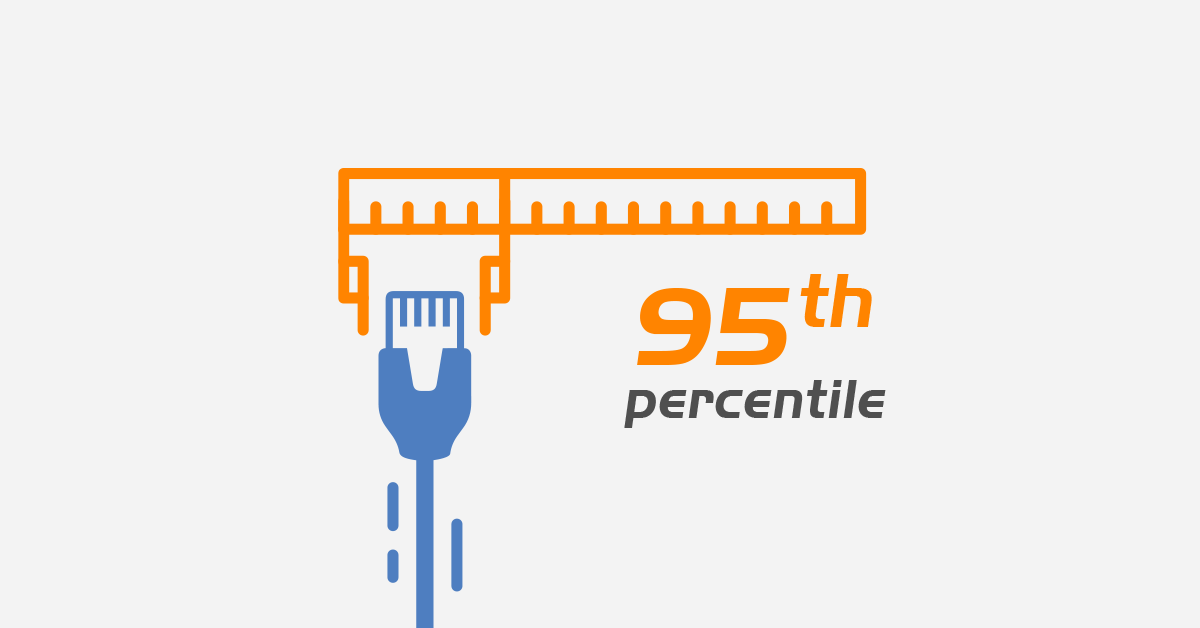95th percentile billing: how the rule works in networking
95th percentile billing is a common way providers charge for bandwidth. Instead of billing every single traffic spike, it samples your usage (typically every 5 minutes), discards the top 5% of the highest samples, then bills you on the next highest value—your 95th percentile. This article explains the rule, shows a step-by-step calculation, and shares practical ways to keep costs predictable without degrading performance.
What the 95th percentile rule actually measures
- Sampling window: Traffic is measured at fixed intervals (commonly 5 minutes) across the billing cycle (usually a calendar month).
- Sorting & trimming: All samples are sorted from highest to lowest; the top 5% are discarded as “bursts.”
- Billable rate: The next highest remaining value becomes the billable Mbps (committed or burstable, depending on your contract).
Quick example calculation (5-minute sampling)
- One month ≈ 30 days × 24 h × 12 samples/h = 8,640 samples.
- Top 5% of 8,640 = 432 samples are discarded.
- Sort samples by Mbps. The 8,640 − 432 = 8,208th highest sample is your 95th percentile.
Imagine your traffic sits around 320–380 Mbps most of the month, with a few bursts of 1.2 Gbps during launch events. If those bursts occupy fewer than 432 samples, they won’t set the bill. A steadier plateau (e.g., many hours at 520–540 Mbps) will raise the 95th percentile—and therefore your invoice.
95th percentile vs. flat commit and per-GB billing
| Model | How it bills | When it shines | Watch-outs |
|---|---|---|---|
| 95th percentile | Bill on 95th-percentile Mbps | Spiky but short bursts | Long plateaus raise cost |
| Flat commit (CIR) | Fixed Mbps at a set price | Steady workloads | Over-pay if idle, rate caps |
| Per-GB (95th-free) | Pay for transferred GB | Low/medium total volume | Expensive at high volumes |
How providers implement 95th percentile billing
- Direction: Some bill on the higher of ingress/egress; others sum both. Clarify this in your contract.
- Aggregation: Multiple ports may be billed individually or as a bundle; bundling generally lowers the 95th percentile.
- Traffic type: Certain traffic (e.g., scrubbing center return, private peering) may be included or excluded—confirm up front.
Tactics to lower your 95th percentile (without harming users)
- Even out batch jobs: Schedule backups, map updates, and content prefetching across off-peak hours to avoid long plateaus.
- Use traffic shaping: Token bucket/policers to smooth micro-bursts; aim to keep sustained peaks below target Mbps.
- Leverage CDNs & edge caches: Offload static assets to reduce sustained egress from origin.
- Right-size commits: If you routinely hit 600–650 Mbps, a 500 Mbps commit plus overage may cost more than a 700 Mbps commit.
- Bundle interfaces/sites: Aggregating links or PoPs (where allowed) typically lowers the combined percentile.
- DDoS hygiene: Ensure mitigation is always-on and clarify whether filtered attack traffic is excluded from billing.
Common misunderstandings about the 95th percentile
- “Spikes don’t matter.” Short spikes might be trimmed, but sustained high traffic quickly influences the 95th percentile.
- “It’s unfair for bursty apps.” The model is designed to forgive brief bursts; costs rise only when bursts last long enough to stop being “bursts.”
- “Per-GB is always cheaper.” Not when your total monthly volume is high; 95th percentile favors high-volume with short peaks.
Step-by-step checklist to audit your next invoice
- Export 5-minute (or provider-specific) samples for the whole month, per interface/port group used for billing.
- Verify whether the bill is based on higher of in/out or sum, and whether multiple ports are bundled.
- Sort samples descending, drop the top 5%, read the next value—this should match your “billable Mbps.”
- Compare against your commit; calculate overage using contracted rates.
When to choose 95th percentile for your workload
Choose 95th percentile if you run mostly steady traffic with short promotion or patch bursts (e.g., game server updates, content drops). If your traffic sits at a high plateau for hours daily, consider a higher commit or a flat rate. For teams migrating or scaling, start on VPS, move to Dedicated for consistent performance, or bring hardware via Colocation. Our DDoS protection and peering in RO/EU help keep jitter and loss low for gamers.
Mini worksheet: estimate your 95th percentile
# Pseudo-steps
1. Export 5-minute Mbps samples for last month.
2. If billed on "higher of in/out", use the max(in, out) per sample; if "sum", use in+out.
3. Sort samples desc; discard top 5%.
4. The next value is your 95th percentile (billable Mbps).
5. Bill = max(Commit, 95th) × monthly rate [+ any overage terms].
Next steps with Torchbyte
Want predictable bandwidth costs and resilient networking? Talk to us about commits and bundling options on Colocation or Dedicated Servers. If you’re starting out, our VPS plans make it easy to scale. For protection against volumetric events, see DDoS protection and our engineering posts on Firewall Panel and XDP.



